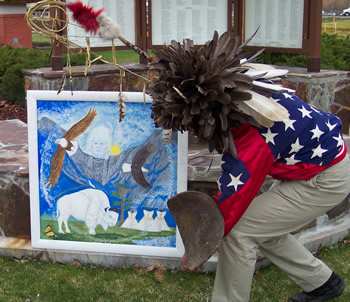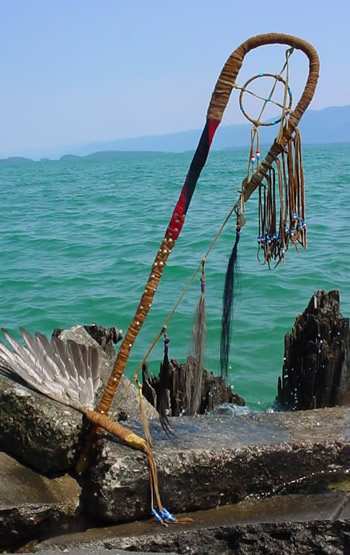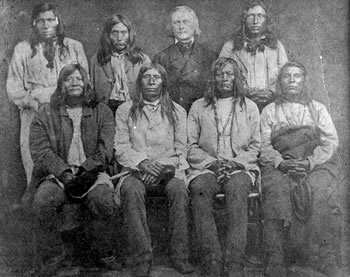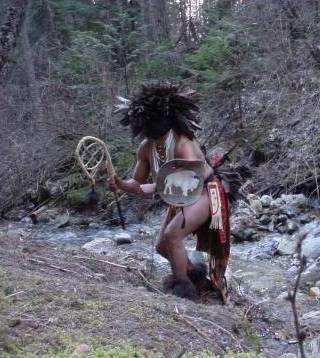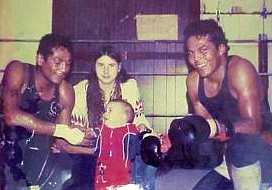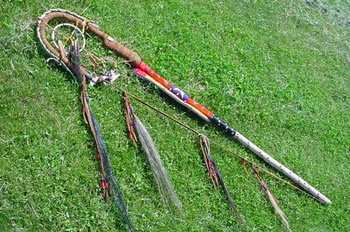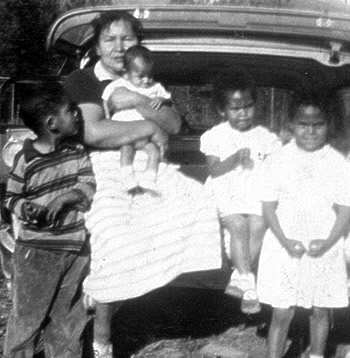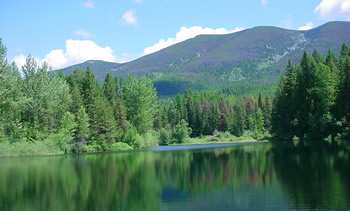The Salish Greeting Ceremony
(Speaks in language)
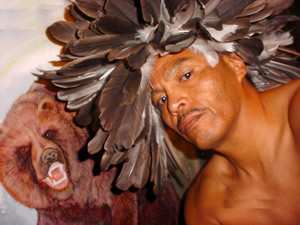 Good day, how are you doing today? My name is C’o Si Nemqmqey. It’s War Hoop Camel in Salish Pend D Oreille language. What I will describe to you today is the greeting ceremony of the Salish people. I want to note that it is since the 1600s since that is when the horse first arrived on the shores. The Salish greeting ceremony went like this:
Good day, how are you doing today? My name is C’o Si Nemqmqey. It’s War Hoop Camel in Salish Pend D Oreille language. What I will describe to you today is the greeting ceremony of the Salish people. I want to note that it is since the 1600s since that is when the horse first arrived on the shores. The Salish greeting ceremony went like this:
In the old days when we’d set up our camp we usually generally set it up in a flat location that gave us an opportunity to set up scouts on the four directions. Whenever these scouts had observed something either it being a man or animal they reported it back to the main camp.
The Salish coup stick is a long stick that was used for striking or touching friends in a meeting ceremony. When this scout came back loping his horse or singing it was known that he had seen something, whether it being a visitor or was it an animal.
If a party was approaching on a friendly visit, even when they were known to be coming and were undoubtedly friendly, a number of mounted warriors went out to greet them. They would put on their war regalia and mount their finest horses and get to a group.
When within sight they advanced toward them in a line abreast, singing. When within a few hundred yards they broke into a gallop and charged on the visitors as if in war. It was said that if a person was there with good intents that he would not run or flee and if he had suspect notions in his heart he would take off, but if he was a good person he would stay his ground and he had nothing to worry about.
When within striking distance they all reined up their horses short, and one of them, most notably the medicine man of the group, went out and tapped the leader of the visitors on the shoulder with the stick. When touched, he said, “Ye-e”. This was to have said that he had chosen him as a friend.
Lem lmts ( thank you)
That is the coup stick greeting ceremony of the Salish people of northwestern Montana.
Sehoy says C’o Si Nemqmqey
The End.
Ken Camel
Kenneth Lloyd Camel’s tribal affiliation is the Pend D Oreille tribe, this name is actually a French word meaning “Earring people,” “Ear-Drops,” and “Hanging Ears.” The name was given to them by the early traders that came through the area. When they first met nearly all wore large shell earrings. The shells were obtained from several sites: the Flathead lake, and Pend D’Oreille River, and formed an article of export. The tribe was also known as “Upper Pend D Oreille” in contradiction to the “Kalispel” who were sometimes called,” Lower Pend D Oreille.” The name for themselves was Ssc’lictcen used by the Kalispel and all the other tribes of the group. Ken prefers to be called a Pend D Oreille warrior for which he seeks guidance on his chosen journey. In 2000 he participated in the Jump Dance and requested the name Warhoop, which translates to C’o Si. The strong emphasis is on the “C” which is like the “Ch” in church. His name translates easily into Co Si Nemqmqey or War Hoop Camel. He currently lives on his “Peoples” reservation more formally referred to as the Confederated Salish and Kootenai Reservation. We adopted the Salish to include both the Upper & Lower Pend D Oreille tribes.
The reservation for which they traded 20 million acres for 1.2 million acres is located in Northwestern Montana by the shores of Flathead Lake. This has been the home of his band of Plateau & Basin tribes for over 12-15,000 years. There are 34 different tribes or groups in the Salish speaking group. The early tribes were nomadic and had seasonal camping spots, which form the basis of his stories. Both historically and contemporary perspectives.
The Salish People hunted buffalo, elk, deer, mountain goats and harvested the bounty of the grains, berries and camas plants. The water was also a provider. They fished for sturgeon and harvested abalone shells to make jewelry and use for trading. They followed yearly migration routes that started in northwestern Montana, into Idaho, part of Washington and up into Canada. Some of the worlds most beautiful and resource rich lands are located here. His learning and formal education has taken him over 14 years to obtain. A background in business administration, forestry, computers, and Native American art provides him with a vast background of untold richness. He was borne and raised at the foothills of the Mission range. His playground was filled with the adventures of his ancestors. To the east are towering mountain ranges that exceed elevations of 10,000 feet, and to the west is the Flathead River, which contains a semi-arid plain. The aboriginal migration routes of his People mimic the conditions now found on his people’s reservation. The Rocky Mountains provide the stables that sustained his People for the millennia. The buffalo plains across the Rocky Mountains to the east were frequently visited during the summer and fall. The mountains provided deer and elk. Huckleberries were found in abundance in the high elevations. Match this with the arid lands that exist along the River. His people are considered blessed with a wide variety of landforms, and untold resources. Along the river to the causal observer contains only sagebrush, antelope and formally buffalo. It also holds a hydroelectric dam that was built in the early 1900’s on a sacred site called the Salish Falls. This dam is called Kerr Dam for which we will finally gain managerial control after 100 years of betrayal. The mid-valley was flush with vegetation where camas grows readily. The glacial till provided the perfect growing conditions for many of nature’s staples. Ken is well rooted in his life goals, as he had dreamed of being a teacher of his native language since he was a child. He is currently developing a language-training program that includes common words and passages for the people that want to learn the Salishian language. He uses his own personal experience in learning the language as a guide.
His mother Alice Nenemay-Camel is the spokesperson on the language series. As he has learned, the early peoples didn’t have a written language. It was interpreted by the early anthropologists and linguistic person that documented it using the English alphabet. His wisdom statement,” Sure you can learn from books but to truly understand the sounds you must hear it from an Elder”, which Ken hopes to be considered one day. He considers himself a warrior. If I was borne at another time I would have been considered a warrior.either here or in Africa.”
Ken has a unique history that tells of his reasons for calling himself a warrior. He is the son of Henry and Alice (Nenemay) Camel. Ken and his family are very proud of their mothers given Salishian name, which is Nenemay. My mothers’ people are members of the Qusic Tribe of Washington, and are located near Spokane Washington. She “is only one-of-five” living full blood Upper Pend D Oreille. His mother met Henry Williams Camel while in Portland Washington when he was in the Navy and she worked in the shipyards as one of the “Rosie the Welders” during the war. The Indian Relocation Act led her there. They were married in Portland, Oregon and returned to Montana to begin what has been considered a storied life on her tribal allotment near Dixon, Montana. Alice Nenemays’ father was a horseman. His name was Alex Nenemay who was a very prominent figure in the family. Alex was one of the largest horse raisers in the area. One recent major land purchase was named after him. It is called the Nenemay Range Unit. Also, Henry Camel had experience working on a farm in the rural south. His birth place was Monrol, North Carolina. After they found the land arid they went to the Tribal council and substituted her original allotment located near Dixon and choose an 80 acre site at the base of the Mission mountains. Ironically it was also the location of several other family groups. It was a sacred vision quest site called mount CaLawken (Beaverhead). They etched out a life as a farmhand and eventually a horse trainer on a ranch. Ken attempts to intertwine stories with legends and personal stories of the warrior.
The Camel family consists of 14 siblings and is well known for being high achievers on and off the athletic field. Along with his brother Marvin Camel, a former two time world boxing champion and was accepted into the Native American Sports Hall of Fame, Ken was a professional boxer. However, he knew his calling lay outside the boxing ring. He retired at 23 years old and is now in his senior year studies at the Salish and Kootenai College to obtain a Bachelor of Science degree. Ken’s history of meeting social and physical challenges may not be unique, but after he worked as an aerial smoke jumper for the U.S. Forest Service it gave him the surreal experience of jumping out of an airplane, he explains it with the passage,” I felt like an eagle.”
As a developing tribal historian, Ken includes presentations on history in the making. The concept and development of the person into a warrior is his goal. He uses his art talent and physical abilities when describing the Salish Coup Stick meeting ceremony of Lewis and Clark and the Flatheads. He is knowledgeable about the history of the coup stick, he says, “its a curved stick, not a weapon”, which is used for greeting ceremonies. Ken has vast experience as a civil rights speaker and has spoken during the Martin Luther King Jr. His father, Henry, instilled a great respect for those that are willing to give everything in the name of the People. He has spoken at several memorial gatherings at the University of Montana, and local gatherings.
Ken is developing a program of helping the local at-risk-youth in understanding their roles in this world. Ken wants to help the young people get prepared for the challenges of the world, just as he was helped. His dream youth is now coming to bear the fruits of his labor . He wants to be a teacher and help children find themselves. He wants them to learn their heritage, culture, traditions and language. He also wants his audiences to know what it’s like living on a reservation, and the challenges and experiences being of mixed blood. Also as a storyteller, Ken shares legends of his People. Caring to learn them correctly from the true elders. Listen to the wind my friends, that is where the answers are.
In his presentations he uses a story about the creation of the Salishian land:
A giant monster once ruled the land. The “One who Sits on Top” was preparing the land for the humans. So he sent the coyote to prepare the places, also he sent the fox along with him. As he knew the coyote would eventually get himself in some situation where he needed the fox to jump over his “dusty bones.” They came to slay the monster. Once they found the monster, they found it took the form of a big horn ram, so they pondered what they would do. The coyote knew the big horn ram loved to ram into things so he developed a plan in which he tricked the ram into running into a giant ponderosa pine tree where the ram’s horn became imbedded into the tree. The ram died and the land was now ready. The site of this tree became known as the medicine tree, and is now considered a sacred site by this and other plateau and basin tribes.
Sehoy.
Ken Camel
PO Box 1492
Polson, MT 59860
(406) 883-2888 x7259 wk
406-883-2935 hm
kenc@cskt.org

